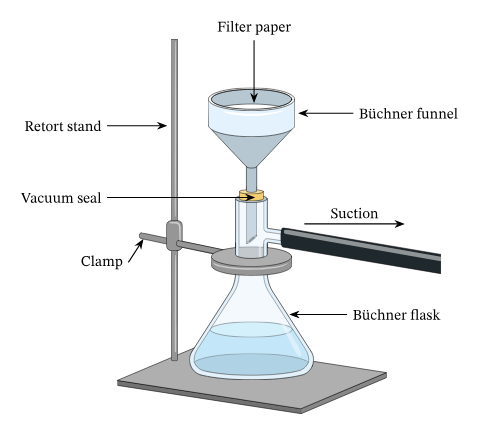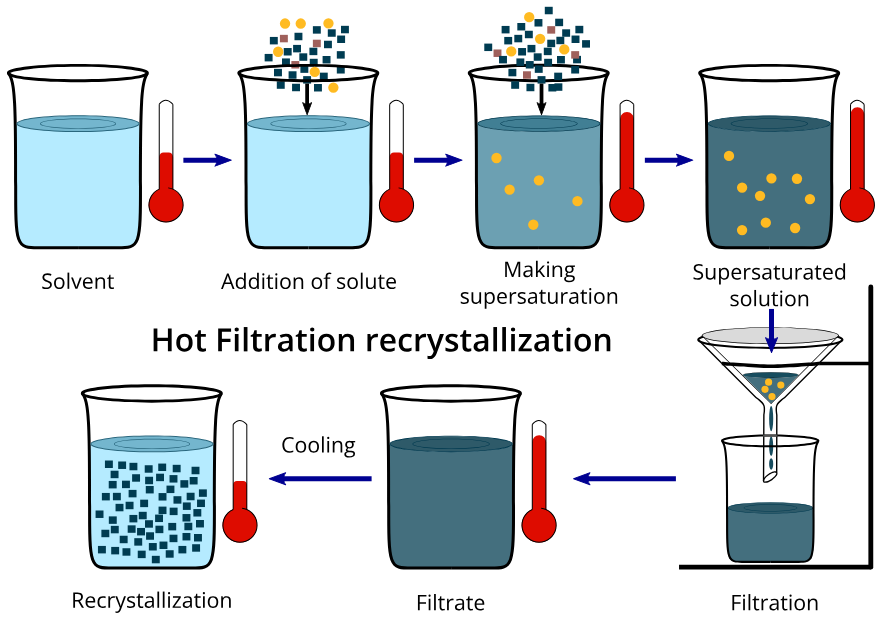Filtration of Mixtures (मिश्रणों का निस्सारण)
Filtration of Mixtures: Detailed Explanation with Methods and Examples
What is Filtration?
Filtration is a physical separation process used to separate insoluble solids from liquids or gases by passing the mixture through a filter medium. The filter allows the liquid or gas to pass through while retaining the solid particles.
Filtration is commonly used in:
- Water purification
- Air purification
- Chemical laboratories
- Food processing industries
Principle of Filtration
Filtration works based on particle size difference. The solid particles are too large to pass through the filter, while the liquid or gas molecules pass through easily.
Key Terms:
- Filtrate → The liquid or gas that passes through the filter.
- Residue → The solid particles left on the filter.
- Filter Medium → The material (paper, cloth, membrane, etc.) used to separate the mixture.
Types of Filtration Methods
1. Gravity Filtration
- Uses the force of gravity to pass the liquid through a filter.
- Simple and commonly used in laboratories.
Examples:
- Separating sand from water using filter paper in a funnel.
- Removing solid impurities from juice.
2. Vacuum Filtration
- Uses a vacuum pump to speed up filtration.
- More efficient than gravity filtration.
Examples:
- Used in chemical labs to separate precipitates from solutions.
- Purification of pharmaceuticals.
3. Hot Filtration
- Used for separating crystalline solids from hot solutions.
- Prevents unwanted crystal formation in the filter.
Examples:
- Filtering hot sugar syrup to remove impurities.
- Separating recrystallized compounds in chemistry labs.
4. Cold Filtration
- Used for filtering materials at low temperatures.
- Prevents dissolved substances from crystallizing in the filtrate.
Examples:
- Removing impurities from cold beverages.
- Filtration of cold chemical solutions in scientific experiments.
5. Ultra-Filtration
- Uses special membranes to remove very small particles, including bacteria and viruses.
- Commonly used in water purification and medical applications.
Examples:
- Purification of drinking water.
- Filtration in kidney dialysis machines.
6. Air Filtration
- Used to remove dust, pollen, bacteria, and other particles from the air.
- Important in industrial and household air purification systems.
Examples:
- Air filters in air conditioners and purifiers.
- Filtration of smoke and pollutants in industries.
Applications of Filtration in Daily Life
- Water Purification – Removing dirt and debris from water.
- Air Purification – Using HEPA filters to clean the air.
- Tea or Coffee Brewing – Separating tea leaves or coffee grounds.
- Cooking Oil Purification – Filtering used oil to remove food particles.
- Pharmaceutical Industry – Purifying medicines during production.
Filtration is an essential process in many fields, making it easier to separate useful substances from unwanted materials.
IN HINDI :-
मिश्रणों का निस्सारण: विधियों और उदाहरणों के साथ विस्तृत व्याख्या
निस्सारण क्या है?
निस्सारण एक भौतिक पृथक्करण प्रक्रिया है जिसका उपयोग अघुलनशील ठोस पदार्थों को द्रवों या गैसों से अलग करने के लिए किया जाता है, जब मिश्रण को एक फिल्टर माध्यम के माध्यम से निकाला जाता है। फिल्टर द्रव या गैस को गुजरने की अनुमति देता है, जबकि ठोस कणों को रोकता है।
निस्सारण का सामान्य उपयोग निम्नलिखित स्थानों पर किया जाता है:
- जल शुद्धिकरण
- वायु शुद्धिकरण
- रासायनिक प्रयोगशालाएँ
- खाद्य प्रसंस्करण उद्योग
निस्सारण का सिद्धांत
निस्सारण कणों के आकार के अंतर के आधार पर काम करता है। ठोस कण फिल्टर के माध्यम से गुजरने के लिए बहुत बड़े होते हैं, जबकि द्रव या गैस के अणु आसानी से गुजर जाते हैं।
मुख्य शब्दावली:
- निस्सारित पदार्थ (Filtrate) → वह द्रव या गैस जो फिल्टर के माध्यम से गुजरता है।
- अवशिष्ट (Residue) → वह ठोस कण जो फिल्टर पर रहते हैं।
- फिल्टर माध्यम (Filter Medium) → वह सामग्री (कागज, कपड़ा, झिल्ली, आदि) जो मिश्रण को अलग करने के लिए उपयोग की जाती है।
निस्सारण विधियों के प्रकार:
गुरुत्वाकर्षण निस्सारण (Gravity Filtration)
यह विधि द्रव को फिल्टर के माध्यम से गुजरने के लिए गुरुत्वाकर्षण बल का उपयोग करती है। यह सरल है और प्रयोगशालाओं में सामान्यत: उपयोग की जाती है।
उदाहरण:- फिल्टर कागज का उपयोग करके बालू को पानी से अलग करना।
- रस से ठोस अशुद्धियों को हटाना।
सक्षरण निस्सारण (Vacuum Filtration)
यह विधि निस्सारण को तेज करने के लिए वैक्यूम पंप का उपयोग करती है। यह गुरुत्वाकर्षण निस्सारण से अधिक प्रभावी है।
उदाहरण:- रासायनिक प्रयोगशालाओं में घोलों से अवक्षेपों को अलग करना।
- औषधियों की शुद्धता।
गर्म निस्सारण (Hot Filtration)
यह विधि गर्म घोलों से क्रिस्टल ठोसों को अलग करने के लिए उपयोग की जाती है। यह फिल्टर में अवांछित क्रिस्टल के निर्माण को रोकती है।
उदाहरण:- गर्म शर्करा सिरप को फिल्टर करके अशुद्धियाँ निकालना।
- रसायन विज्ञान प्रयोगशालाओं में पुनः क्रिस्टलीकरण के बाद यौगिकों को अलग करना।
ठंडा निस्सारण (Cold Filtration)
यह विधि कम तापमान पर सामग्री को फिल्टर करने के लिए उपयोग की जाती है। यह निस्सारित पदार्थ में घुली हुई सामग्री के क्रिस्टलीकरण को रोकती है।
उदाहरण:- ठंडे पेय पदार्थों से अशुद्धियाँ निकालना।
- वैज्ञानिक प्रयोगों में ठंडी रासायनिक घोलों का निस्सारण।
अल्ट्रा निस्सारण (Ultra-Filtration)
यह विधि विशेष झिल्लियों का उपयोग करती है जो बहुत छोटे कणों को, जैसे बैक्टीरिया और वायरस, को हटा सकती है।
उदाहरण:- पीने के पानी की शुद्धि।
- गुर्दे की डायलिसिस मशीनों में निस्सारण।
वायु निस्सारण (Air Filtration)
यह विधि वायु से धूल, पराग, बैक्टीरिया और अन्य कणों को हटाने के लिए उपयोग की जाती है। यह औद्योगिक और घरेलू वायु शुद्धिकरण प्रणालियों में महत्वपूर्ण है।
उदाहरण:- एयर कंडीशनरों और एयर प्यूरीफायरों में एयर फिल्टर।
- उद्योगों में धुएं और प्रदूषकों का निस्सारण।
निस्सारण के दैनिक जीवन में अनुप्रयोग:
- जल शुद्धिकरण – पानी से गंदगी और मलबा हटाना।
- वायु शुद्धिकरण – HEPA फिल्टर का उपयोग करके हवा को शुद्ध करना।
- चाय या कॉफी बनाना – चाय की पत्तियाँ या कॉफी के अवशेषों को छानना।
- खाना पकाने के तेल का शुद्धिकरण – इस्तेमाल किए गए तेल से खाद्य कणों को हटाना।
- फार्मास्युटिकल उद्योग – उत्पादन के दौरान औषधियों की शुद्धता।
निस्सारण एक महत्वपूर्ण प्रक्रिया है जो कई क्षेत्रों में उपयोग की जाती है, जिससे यह उपयोगी पदार्थों को अवांछित सामग्री से अलग करने में आसान बनाता है।







Comments
Post a Comment